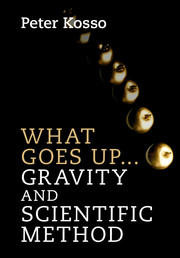
-
Select format
-
- Publisher:
- Cambridge University Press
- Publication date:
- March 2017
- January 2017
- ISBN:
- 9781316417003
- 9781107129856
- Dimensions:
- (247 x 174 mm)
- Weight & Pages:
- 0.62kg, 232 Pages
- Dimensions:
- Weight & Pages:
You may already have access via personal or institutional login
Book description
The concept of gravity provides a natural phenomenon that is simultaneously obvious and obscure; we all know what it is, but rarely question why it is. The simple observation that 'what goes up must come down' contrasts starkly with our current scientific explanation of gravity, which involves challenging and sometimes counterintuitive concepts. With such extremes between the plain and the perplexing, gravity forces a sharp focus on scientific method. Following the history of gravity from Aristotle to Einstein, this clear account highlights the logic of scientific method for non-specialists. Successive theories of gravity and the evidence for each are presented clearly and rationally, focusing on the fundamental ideas behind them. Using only high-school level algebra and geometry, the author emphasizes what the equations mean rather than how they are derived, making this accessible for all those curious about gravity and how science really works.
Reviews
'In Kosso’s most recent work, the philosopher and physicist exhibits precision in language and thought. In a sense, What Goes Up is three works in one. A history of physics is intertwined with a non-mathematical conceptual physics text. Arising out of these two comes a philosophy of physics glue that binds the first two together. The evolution of one’s 'understanding of gravity' … is used as the narrative, leading the reader from cover to cover. Philosophically, Kosso … helps the reader appreciate the scientific method as it comes to maturity out of a cooperation between observation and theory. He discusses such topics as the 'distinction between description and explanation', instrumentalism, and causal mechanisms. Especially easy to follow is his conceptual presentation on the metric and the manner in which the principle of equivalence leads to the gravitational red shift and the slowing of clocks - both normally difficult topics in general relativity.'
J. F. Burkhart Source: CHOICE
'I would say that it is about how scientific knowledge develops over time, using the historical evolution of our understanding of gravity as a guiding thread. … What Goes Up … is certainly an excellent guide to the science of gravity and its historical evolution, from the standpoint of a 21st century expert. It is interesting, for instance, to compare the ‘theories of principle’ of Aristotle and Einstein with the ‘constructive theory’ of Newton. … The text is well written and accessible. My teenage children learned about non-Euclidean geometry from figures in the book and were intrigued by the thought that gravity is not a force field but rather a metric field, which determines the straightest possible lines (geodesics) between two points in space-time.'
Carlos Lourenço Source: CERN Courier
Contents
Bibliography
Rewarding Reading on Gravity and Scientific Method
This is a history of the merger of astronomy and physics, from Aristotle to Newton, in a clear, lively presentation with impressive attention to detail. Barbour writes “from a Machian point of view,” laying the foundations for relativity without distorting the history.
Philosophers of science have a lot to say about the methods and limitations of science. Here is a readable guide to topics such as underdetermination, instrumentalism, testing, and interpretation of evidence.
From Aristotle to the present, this explains the fundamentals of physics, including mechanics, electrodynamics, and quantum mechanics, in historical and methodological context. There is some math, and this makes the book a good source for understanding the details of derivation of important results.
Gravitational lensing and dark matter are explained with enthusiasm and insight by a respected astronomer. Here is where you can get more details on the bullet cluster and the evidence for the existence of dark matter, as well as the different ideas of just what dark matter is.
Kuhn is most famous for The Structure of Scientific Revolutions in which he introduces and develops the concept of a paradigm, but his ideas began with this study of the Copernican revolution. The history, from Aristotle to Kepler – and a little Newton – is helpful for understanding the scientific details and provocative for thinking about science.
This is where to go for more detail on the foundational concepts of gravity from Newton to relativity, with little reliance on mathematics. Modern cosmology and astrophysics are developed around the influence gravity.
This is not explicitly about scientific method, but it has some of the clearest insights on scientific method you will find. It makes a genuine contribution to philosophy of science, despite a chapter called “Against Philosophy.” Weinberg is a Nobel Prize winning physicist, and the book is about the hope of unifying all forces of nature into one theory.
Additional References
Metrics
Full text views
Full text views help Loading metrics...
Loading metrics...
* Views captured on Cambridge Core between #date#. This data will be updated every 24 hours.
Usage data cannot currently be displayed.
Accessibility standard: Unknown
Why this information is here
This section outlines the accessibility features of this content - including support for screen readers, full keyboard navigation and high-contrast display options. This may not be relevant for you.
Accessibility Information
Accessibility compliance for the PDF of this book is currently unknown and may be updated in the future.


